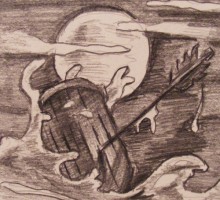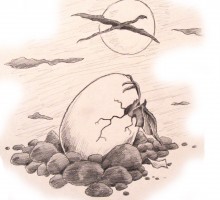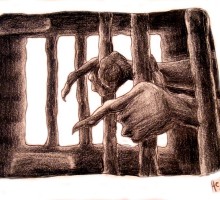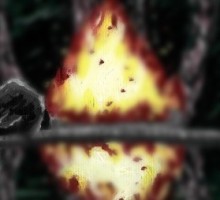I think I might be going too fast in the beginning. There I said it.
I read other short stories in the ‘Improbable Truth’ anthology and compared them to mine. Then I skimmed the old opening of the original StoneDragon draft, the last full version I wrote, and I found fast dialogue and action, but not a lot of setting, backstory, or context, at least in the first few pages. I dropped the reader into a fast moving stream and expected them to start swimming, without help. And maybe with a few arrows falling around their head (my featured image was boring until I added the arrow, which I have to tie in somehow!).
But seriously, I think I need to aim for slightly longer paragraphs early on, of adding something that isn’t fast moving action or dialogue, at least in the first few pages. Setting, mood, detail. Something to allow my reader’s mind to settle in, pick up the point of an individual paragraph and absorb it, before being assaulted by a new and completely different idea, every sentence or two. Or at least not until the pacing is intended to pick up and the reader is comfortably ensconced in the scene.
I should probably note that this flaw is probably better than the reverse: being too slow and predictable, which is the kiss of death, but I still have to write down my flaws when I see them–and I think I see one.
Hopefully, I’m not be as bad as I used to be when I first wrote that early StoneDragon draft, and I definitely don’t want to swing completely to the other side of the pendulum, and have a pedantically boring opening, but I think that I will probably add this question to my checklist of items when I’m editing a story. I’m still going to try having an opening that grabs you, but hopefully not at a speed where you are lost.
A fast moving stream can shock you, wake you up, and get your heart rate racing. All good things for a chapter. But if the water’s too fast and deep, you’re just going to drown…
Especially if you get shot by arrows. 😉
__________________________________
A new sketch for the post. I also have a hockey injury tonight: a slapshot to the little finger. A lot of blood and the nail is mottled black. So not much extra typing going on. 😉 Most of this post was done beforehand. Before ‘hand’, he he. Okay, maybe a bit light headed from blood loss and a single beer. Hope your night went better!
On the WIP front, I’m finally shockingly happy with the outline and am cleaning up my world-building references into organized files in Scrivener before tackling the rewrite. Which will be followed by a paid edit and possibly a copy edit. So still quite a ways from complete. But I’m getting excited by it again, which is a nice change!
PS, I have a guest blog coming soon, which is a first for the blog and pretty exciting, And which will also hopefully give the little finger a chance to recover! 🙂




